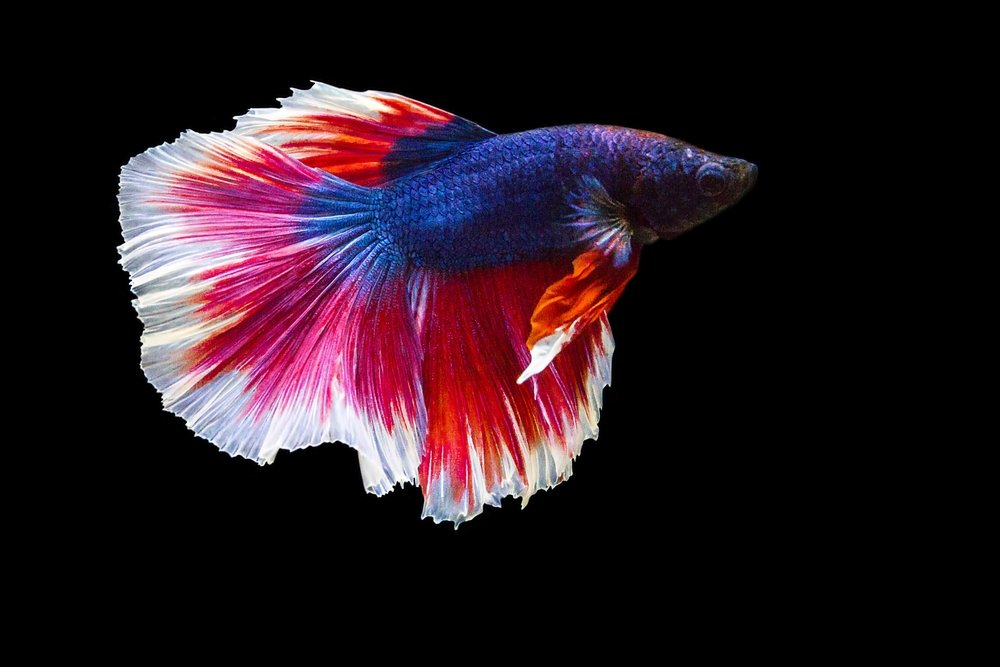Betta fish are some of the most beautiful tropical fish found at your local pet store. Their characteristics and physical features are an appealing catch for aquarium keepers, however can differ quite a bit between the male and female fish. We’ve compiled everything you need to know about Female vs Male Betta Fish right here.
Female vs. Male Betta Fish
Knowing the general characteristics of male and female bettas is helpful when deciding which ones would best suit your aquarium. For example, male bettas don’t bond with females. They can be paired for breeding for a limited time. Whereas female bettas can be kept in community aquariums with other species.
Understanding their differences can also help you tell them apart, along with which gender is more likely to end up with health problems or other issues.

Do You Own a Betta Yet? Here Are 9 Stunning Bettas That Can Be Delivered Right to Your Door!
 Top Top | Male Halfmoon - Asst Colors | View on AMAZON | |
 Top Top | Halfmoon Rosetail | View on AMAZON | |
 Top Top | Dumbo Halfmoon | View on AMAZON | |
 Top Top | Betta Splendens - Assorted Colors | View on AMAZON | |
 Top Top | Half-Moon Females x4 - Assorted Colors | View on AMAZON | |
 Top Top | Male Galaxy | View on AMAZON | |
 Top Top | Crowntail x4 Female Assorted Colors | View on AMAZON | |
 Top Top | Show Male Green Mustard Halfmoon Assorted Colors | View on AMAZON | |
 Top Top | Super Delta | View on AMAZON |
Female Betta Fish
Female bettas tend to be a little smaller with the same dramatic pigmentation pattern as males. They don’t have as vibrant colors or large fins and usually have a more docile nature. Egg spots are on the bottom of the fish, just behind the ventral fins. This visual difference is called sexual dimorphism.
Male Betta Fish
Male bettas are small, hardy, and colorful tropical fish native to Southeast Asia. Their fins are bright and large to attract mates and to show at other males to warn them off. Male betta fish are larger and than females of the same type. Males will show aggression towards other bettas.
Appearance – Male vs. Female Bettas
Bettas represent a large part of what the ornamental fish trade can offer.
Wild bettas are usually a brown hue with small fins and tails. Captive fish are bred and enhanced for their impressive fins and variety of colors. Enthusiasts have used the basic betta gene of wild fish to create beautiful anomalies, resulting in the current strong sexual dimorphism of captive-bred ornamental lineage betta.
The biggest physical difference is that males will generally have larger fins and more extravagant colors, whilst females tend to fall onto more dull, less vibrant colors. This makes it fairly straightforward to distinguish between the sexes.
Behavior – Male vs. Female Bettas
Male bettas tend to be notoriously intolerant, showing a high degree of aggression towards each other, even their own reflection if it’s visible. It’s common for them to widen their gills and show their fins to portray dominance against other fish.
Female bettas have a more docile and friendly persona, they can be kept in community aquariums with other fish without problems.
When groups of male and female bettas are put together, they usually end up with torn fins and dead fish unless you create a vast space with lots of hiding places and barriers in sight range.

Which Betta Gender is Best For You?
Both male and female bettas have their pros and cons, and you can keep one or both of them in your fish room, depending on your aesthetic preferences and purposes. If adding color and personality to your collection is your goal, a betta fish would be the perfect choice.
The best way to decide which fish might be better suited for you, is understanding which types of aquariums can house them.
If you’re wanting a modern setup in a smaller aquarium, the male betta is an excellent choice. You could place it in an aquarium equipped to keep aquatic plants along with your fish, making it comfortable in a similar environment to its natural habitat.
Female bettas are a good choice for community fish tanks, adding color to the aquarium and friendly behaviour towards tank mates.
Keeping Bettas Together
When it’s time to breed your betta and you have to put both genders in the same tank, there’s a few things you can do to prevent the male from killing the female during courtship. Using an aquarium divider is a good first step to accustom the bettas.
If it’s possible for you, keeping three or more females for each male. This helps the females stand more of a chance, rather than just one single female being stalked.
If you intend to breed bettas, you will need to be well set up for spawning and for raising betta fry.
Males take the full responsibility for caring for the eggs and raising fry. They build a bubble nest and place the fertilized eggs into it, taking great care to keep the nest clean, aerating the nest, defending it from other fish and replacing any eggs or fry that break free from the nest.
Health and Care
The main concern for a male betta’s health and well-being is tank layout.
Ideal conditions are a large aquarium with a heating and filtration system, with plenty of greenery to provide shelter and privacy. Plan for an inch of fish per gallon of water and keep in mind that fish need a stable parameter setting that doesn’t fluctuate during the day, so ensure pollutant levels stay low. Dramatic changes increase the risk of illness and stress.
Pet Store Stocking
In our experience, the male betta fish are more commonly available for sale in small pet and fish markets, due to their visually appealing stunning colors and flowing fins.
Female bettas can be sold too, just more difficult to find.
Live betta fish can be purchased online with the fish delivered right to your door.
Female vs. Male Betta Fish For Small Tanks

Tail and Fins
There are more than hundreds of betta with long fins, unique behaviour and exuberant colors. Males often have large fins, but in some species have short fins. Females have a slightly narrower body and generally short tails.
Body Size & Shape
The most critical sign of knowing a fish’s gender is its body shape. Male bettas are flatter, thicker, and longer, whereas the females are often short and tight. Males can grow up to 2.5 to 3 inches, and females can only grow 2 inches.
Whenever your betta fish sees a threat, it expands its gill plate outward. This forward expansion to show more colors and its physique is called ‘flaring’. Both female and male fins are more prominent when enlarged.

Egg Spot
Only the female bettas have egg spots between the anal and ventral ends of the tail (where eggs are laid).
Prices pulled from the Amazon Product Advertising API on:
Product prices and availability are accurate as of the date/time indicated and are subject to change. Any price and availability information displayed on [relevant Amazon Site(s), as applicable] at the time of purchase will apply to the purchase of this product.
Body Stripes
Horizontal stripes enhance the glamor and beauty of female bettas. The lines on their body represent their sexual maturity and demonstrate that they are ready to mate. Of course, these stripes are only seen on females.
Final Comments
Betta fish are a beautiful and interesting addition to your aquarium. However, making sure you have a tank that’s suited to the needs of the Female vs Male Betta Fish is an important aspect to keep them happy and thriving.
.
















![Top [2023] 10 Best Nano Reef Tank Options For Beginners Top [2023] 10 Best Nano Reef Tank Options For Beginners](https://aquariumhunter.com/wp-content/uploads/2021/03/ftslarge-1200x795.jpg)
